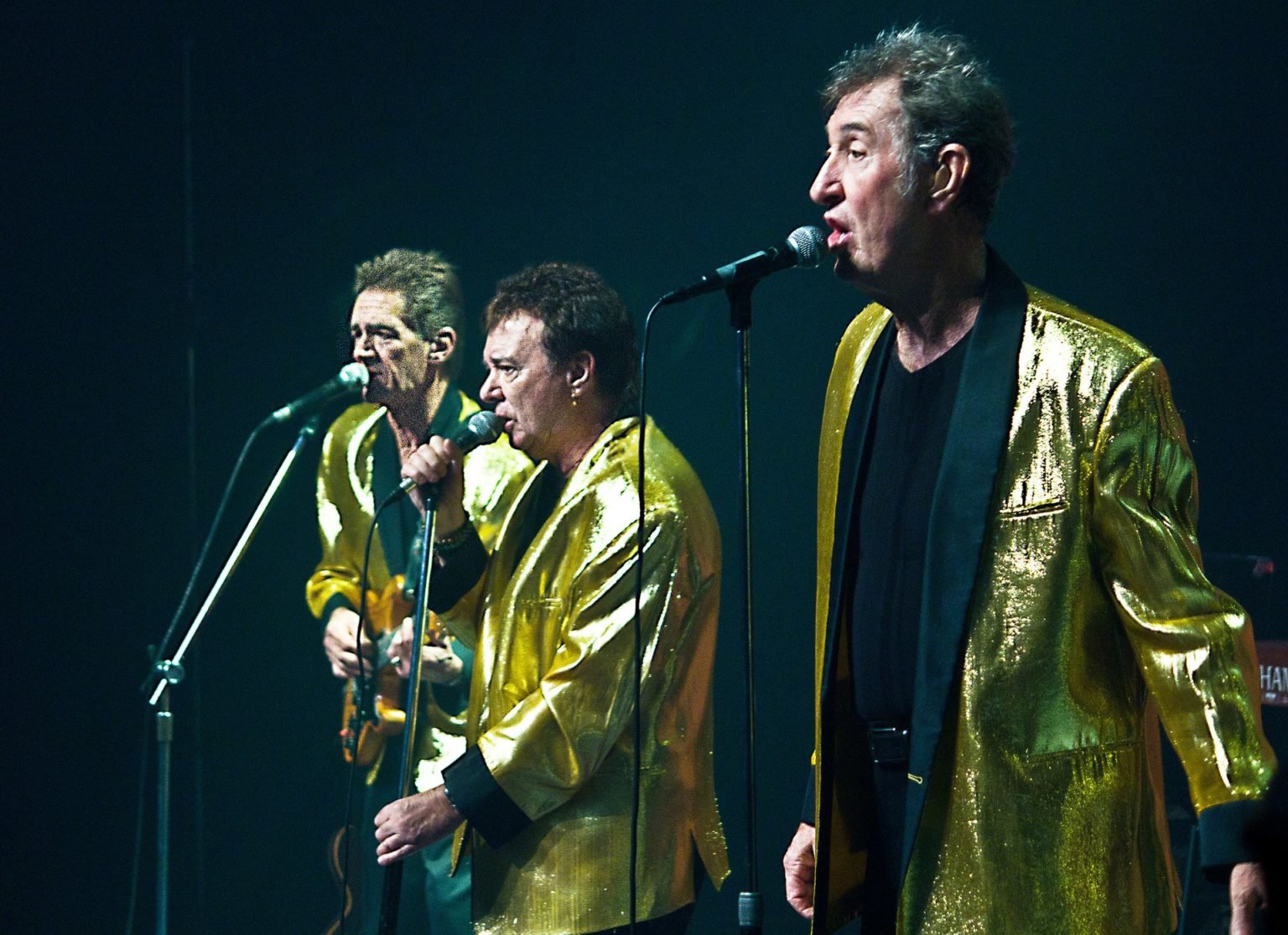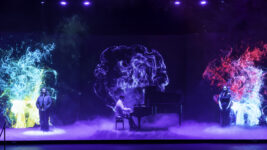News
8 Dec 2021
The Gaffa Tapes: Puttin’ on the Glitz

Subscribe to CX E-News
Life is a cabaret…
(lead pic: The Delltones)
A battle-hardened music technician singing the praises of a cabaret gig might suggest a few too many open-air gigs in the midday sun. However, the twilight of my career in live entertainment technology was spent gleefully in that genre.
To some, it might have been as much fun as a funnel web spider, but for me it was a fitting finale to go out amidst the glitz, glamour and complexity of cabaret in the Starlight Room at Wenty Leagues (Wentworthville Leagues Club, Sydney). From the guy on the door decked out in his tuxedo to the off-stage orchestra, Wenty Leagues was a twenty-four carat cabaret venue.
Cabaret, in the modern sense roughly translates to ‘floor show’. It’s basically vaudeville performed in a nightclub or restaurant atmosphere. I’d been smitten since my parents took me to the Tivoli Theatre in Sydney when I was a young lad. The genre typically can be musical entertainment, dancers, jugglers, magicians, stand-up comedians, ventriloquists or all of the above on the same night. And that’s similar to what I was confronted with in the early 90s on my first night as the Starlight Room’s newly appointed sound engineer.
As I waited impatiently on stage for the entertainment manager to sort things out I was informed, “Oh, he doesn’t do that.” So, I thought, why not add Stage Manager to my résumé? I revelled in my newly self-appointed stage management position where I’d meet top-line artists backstage, pass their music charts onto the orchestra and liaise with the various acts as to their needs and the running order of the show.
Dance troupes, some of whom sprinkled Coca Cola to dull the slippery stage floor, would go on first because you couldn’t have them tripping over leads and bumping into stage equipment; and it was too hard to strike the set for them later in the show. When artists brought their own microphones, wireless hand-held, lavalier or head-worn, I’d take them up to the 24-channel Soundcraft desk in the upstairs bio box, assign a channel and adjust the gain structure according to the sensitivity of the particular microphone. And sometimes, to the artist’s displeasure, I’d have to substitute their personalised wireless microphone systems because they were sitting on some taxi’s two-way radio frequency.
I was a bit of a stickler for crisp foldback devoid of any feedback, and the FOH graphics had to be adjusted to allow a feedback threshold for artists who would sometimes leave the stage and perform amongst the audience. In the case of Simon Gallaher, his whole grand piano/vocal performance was done on the floor in front of the speakers.
The upstairs bio box sported a Jands lighting desk (not sure of the model) and we had a nice array of par cans, Fresnels, and profiles to play with. We also had a regular follow spot operator, and on special occasions a casual was employed to operate the second follow spot.
When the venue featured theatrical acts, the lighting guy would be warming the curtains with a nice wash of red while he went over the lighting plot. The room would fill with the ambient sounds of the orchestra warming up while I’d be running final checks or liaising with an MD who would be offering tips on how I should mix the show (one can’t be too precious about one’s ability in these situations). This was also the beginning of the digital age when the drummer would sometimes be cued by a click track and you would have to run a playback track and blend it into the mix.
A wide array of talent graced the Starlight Room in those heady days. They included The Deltones, John Paul Young, Chelsea Brown, controversial British comedian Bernard Manning, Jane Scali, Simon Gallaher, Paul Martell, and Peter Byrne’s Forever Diamond Show, which was an award-winning tribute to Neil Diamond. The Starlight Room was also a popular venue for theatre companies putting on touring shows such as Phantom of the Opera.

After a couple of weeks, the contractor offered to sell me the business, and then in a very nice gesture he said, “Oh, I’ll just give it to you.” So, I suddenly became the Technical Operations Manager (another self-title) and the employer of the lighting and follow spot guys. I had a registered business name, so the guys were paid award wages with PAYG tax deducted for the ATO.
I immediately regimented collar and tie apparel, which was a strange edict coming from a rock ‘n’ roll rebel. Some might argue it was an obsession with power, but you get a lot more respect from artists by being neatly attired, introducing yourself and asking, “How can we help you?” rather than telling them what they can and cannot do.
Some of the bigger acts like The Deltones would bring in their own sound and lighting crews and equipment, which they would integrate with the club’s equipment. It was a kind of night off for us, but we would help in any way we could, and you could always pick up a trick or two.
As traditional theatre masks imply, there is sadness and joy in theatre. There was childish joy in ducking down behind the mixing desk unable to stifle laughter at the not so politically correct Bernard Manning. Conversely, it was a sombre evening for The Cockroaches who turned up in their declining years devoid of crew to play to an empty house. However, it did give us the opportunity to do the sound and lighting for a band that had once been a headliner act.
There were some amusing occasions that I tend to dwell on, like the time a particular artist of the 50s/60s Bandstand era asked what were the large boxes in front of him, and could they be removed. “They are your foldback wedges, sir,” I remarked.
“Well, can you put them over there on the sides of the stage?”
“Yes, but you won’t be able to hear yourself.” Nevertheless, at his insistence the wedges were placed at the extreme edges of the stage. Half way through his act the artist paused and addressed the bio box. “Excuse me, Mister Soundman, I can’t hear myself.”
Then there was the entertainer from a children’s show who sent us into panic mode when he began undressing in front of the children. Much to the children’s amusement he stripped right down to his baggy knee-length, brightly-striped boxers. I’m guessing this wouldn’t be appropriate in today’s world.
A magician performing at a senior’s function had intended to surprise his audience with a finale where a dove was to fly out of a bouquet of torn strips of paper. Before releasing the dove he announced, “Well, that’s the end of my show, ladies and gentlemen.” Immediately, the seniors leapt from their seats and scrambled for the free coffee, tea and biscuits, totally oblivious to the spectacle of the dove emerging from the bouquet and flying around the room.
I won’t dwell on the fact that the venue’s entertainment manager zealously guarded his position, and was not too pleased from day-one to see ‘entertainment management’ included on my résumé. Thus our professional relationship during my tenure was less than convivial. And despite being the technical contractor I was consistently refused any written agreement for my services.
Intertwined with the memories of my cabaret experience is the unpleasant memory of returning from my annual vacation to find I had been surreptitiously replaced by another contractor, who had also poached my employees. Alas, my final act was exiting the club carrying the late Chelsea Brown’s suitcases down to her car whilst chatting with the lovely lady.
Subscribe
Published monthly since 1991, our famous AV industry magazine is free for download or pay for print. Subscribers also receive CX News, our free weekly email with the latest industry news and jobs.




